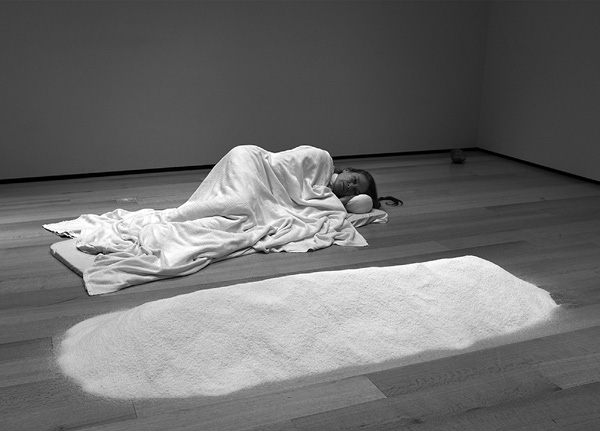
100 WAYS TO CONSIDER TIME, DAY 99: SALT
first performed on February 18, 2016
Jeanne and Stokley Towles Gallery, Museum of Fine Arts, Boston, MA
performed once in 2016
MARILYN ARSEM
Boston, MA
004850047c004850047o004850047n004850047t004850047a004850047c004850047t004850047@004850047m004850047a004850047r004850047i004850047l004850047y004850047n004850047a004850047r004850047s004850047e004850047m004850047.004850047n004850047e004850047t
marilynarsem.net
100 WAYS TO CONSIDER TIME, DAY 99: SALT
MARILYN ARSEM
Dressed in white, lying under a white hospital blanket, I spent six hours contemplating a body-shaped mound of salt, considering my own death, and thinking about what becomes of corpses as they decay. My eyes were open the entire six hours, looking at the body of salt.
“Day 99: Salt” was part of a series of 100 daily performances entitled “100 Ways to Consider Time.” Every day, for 100 consecutive days, I created a new performance on the nature of time. Each performance was exactly six hours in duration, without breaks, but the length and quality of each of those six-hour periods felt profoundly different because of the choice of actions. This penultimate day was the only one in which I was dressed in white; I wore black on all the other 99 days.
Some of the 100 performances were poetic, some practical, others were playful, and some were meditative. I engaged with the audience in many of them. A number of the performances focused on the timescale of material processes of growth and decay. In others I experimented with different methods of measuring time, using mechanical devices, through the mind, with the body, or in relation to specific processes. Some days I read scientific texts out loud; other days were still and silent.
The 100 performances were not planned in advance. Each day’s action grew out of what had occurred the previous day, a single action chosen for each day. They were minimal but straightforward, operating on a human level and scale, using everyday materials. Audience members coming into the room to observe for a few minutes might not see anything that appeared monumental. But the longer they stayed, the more they began to recognize the implications of sustaining that action for six hours.
Many people started to return regularly to the gallery to see what that day’s action would be. They in turn helped to explain the work to newcomers. It is common neither for that museum to show performance art within their galleries nor for an exhibition to change every day.
Printed cards were available in the gallery for the audience, inviting them to participate in the work by responding to the question, “How do you experience time?” More than one thousand visitors to the exhibition responded to the question, leaving written answers in the gallery, sending mail and emails, and posting photos and comments on social media.